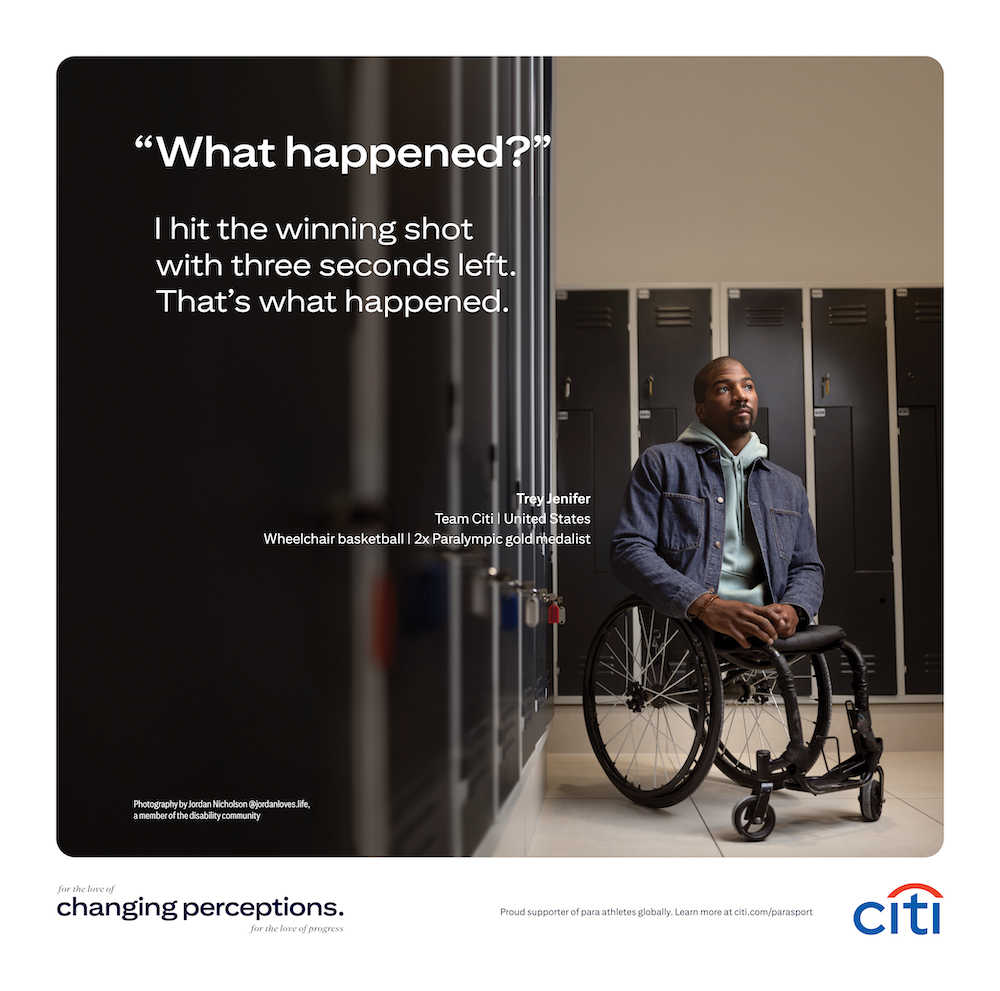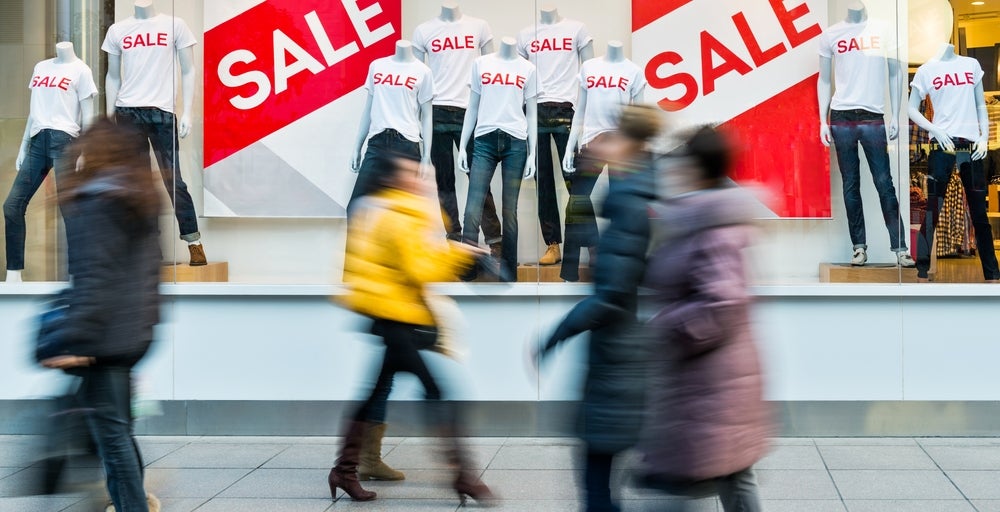
“What we started seeing in the data is that the Para communications were performing slightly better. And when we unpacked that, it was because of the narrative of their journeys. For us, the results were higher in terms of reputation, goodwill, doing good in communities. Part of our mission and value proposition is enabling growth and progress in the communities we serve, and this was a natural extension of that.”
—Tina Davis, Head of Enterprise Marketing and Brand Engagement at Citi
The Paralympic Games, which kicks off in Paris on August 28, has enjoyed sponsorship support from Citi since the 2012 Games in London, when the brand began to focus its marketing more on Para athletes’ personal journeys and achievements. The shift resulted in higher audience engagement and an uptick in brand reputation. Davis credits the campaigns’ authenticity to Citi involving the paralympic athletes themselves during the ideation process. We spoke with the marketing head about the inspiration behind the Games’ “What Happened?” campaign, the strategic business goals of Citi’s involvement, working with Para athletes and more.
Chief Marketer: How did Citi come up with this specific campaign idea and approach?
Tina Davis, Head of Enterprise Marketing and Brand Engagement at Citi: In marketing, we always talk about finding that insight that is going to be compelling in your storytelling. We spent a lot of time with our athletes talking about what we could do in the Para movement because we wanted to be sensitive to the athletes—and this desire not to be looked at as [an] athlete with a disability, but [rather] as a strong human being who is an incredible athlete.
We met with some of them and talked about what it means to be a Paralympian and what they like about it. And one of the things that we found really interesting is that they like to be stared at. They say, “yes, stare at me,” in the sense of, stare at me because of my athletic ability, not because of my disability. That became the kernel of the idea that led to the “Stare at Greatness” campaign that we launched in 2020. And we kept building on it in ’22.
Then for ’24, we touched base again with the athletes. Another insight that they shared with us is this notion of random people on the street asking them, “what happened to you?” We flipped that on its head. Instead of “what happened to you” physically (or, sometimes they’re invisible disabilities), [it’s] what happened to them in their sport. Let me tell you about what happened to me on the basketball court. Let me tell you what happened to me in the pool. Let me tell you how I won a gold medal.
CM: Why has Citi focused more on the Paralympics in recent years? How is that working from a business perspective?
TD: We’ve been involved in the Olympic Paralympic movement since 2012. And in 2012 we were sponsoring Team USA, both Olympics and Paralympics. We had a collection of Team Citi athletes, ensuring that we had a nice spectrum from male/female, ethnicity, able-bodied, Paralympians… From 2012 through 2016, we did Team USA. What we started seeing in the data is that the Para communications were performing slightly better. And when we unpacked that, it was because of the narrative of what their journeys had been. For us, the results were higher in terms of reputation, goodwill, doing good in communities… Part of our mission and value proposition is enabling growth and progress in the communities we serve, and this was a natural extension of that.
We found it so much more impactful for us as a brand from a colleague perspective. It’s one of the few assets that we have that we don’t have to beg the lines of business to contribute money to. They just naturally want to get involved. We use our paralympic athletes for town halls, for volunteer days, for fireside chats. We leverage them across all touchpoints here at Citi. It’s been an easy sponsorship for us to actively get engagement internally and externally. And the byproduct of that is our reputation and goodwill and community scores and social listening—we see them all rise.
CM: What is your involvement in the International Paralympic Committee’s Para Sport group?
TD: Before 2022, we had sponsored Para athletes and we had a strong relationship with the IPC. When they introduced the Para Sport movement, which was founded in 2022, we became a founding partner. It’s a grassroots-to-high-performance program that aims to provide Para athletes and their member organizations with a platform to drive societal progress. They’re creating a pipeline for the next generation of Para athletes and general athletes.
What we loved about that was it was so community-based. When we started in the movement, one of our first campaigns was about shining a light on those community organizations, [because] it helped Olympians and Paralympians on their Olympic journey. This program is a nice manifestation of that notion. We see it as our latest step in our longstanding commitment.
CM: Can you talk about how you work with athletes specifically? How do you leverage that relationship?
TD: It varies from athlete to athlete. We work with them, obviously, in terms of our marketing communication. Depending on the athlete, we work with any of their societal programs that are important to them. We help them try to highlight those. They come to our offices around the world. While we are featuring six athletes in our campaign, we actually have over 50 athletes around the world that we work with. And in different countries they do different things. Some countries feature them in out-of-home. Some countries use them a lot for colleague engagement; they participate in our volunteer programs.
For example, we started working with [the athlete] Scout Bassett in 2012, and she’s become our technical advisor. You know how on a set, there’s a tech person? That’s what she’s become to us over the years. She’s formed relationships with our CEOs around the globe. And we’ve created some really strong relationships—not just professionally, but personally, with the athletes.
Also, our photographer, Jordan Nicholson, has shot for brands like Apple, Nike, Adidas and more. And what we love about him is he has a disability, TAR Syndrome. We believe in this notion of “For us, by us.” We like to bring in people who can help us add another level of empathy to our work and give us another perspective. And he’s done a phenomenal job on the photo shoot.
CM: How did you find him? Was that choice deliberate?
TD: Yes. We want talent, and so that was the first level. And then the work he’s done is incredible. And the ability to provide empathy. There was another campaign we did called Chosen Name, for transgender people who have a different name than their ID for their credit card. We used transgender actors and directors. We found that mix, that combination, to be really powerful for the work. We try to do that when we can and we seek out that talent—because many times that talent isn’t getting the first call, so we’re looking to help spread the love.
CM: How is his photography different?
TD: It’s not so much that it’s different. If you looked at it, you wouldn’t say, oh, this must’ve been done by somebody with a disability. It’s more about the sympathy and the empathy that he brings to the process, and how you film somebody. For instance, [he might say] let’s not be so obvious. Is there a more subtle way to shoot someone with a disability? The athletes are more comfortable with him as well, because they have this unspoken dialogue, this shorthand with one another.
CM: A paralympic campaign has less reach than the Olympics. How do you deal with that challenge?
TD: It does have less reach than the Olympics, but I would say it’s on a trajectory of reaching Olympic level in terms of audiences. It’s this notion of, if you build it, they will come. It’s just like the WNBA: When people started seeing what badasses these girls were, they leaned in. They participate.
As people are looking for other live sporting events, this is one of the ones that is up next. Yes, the viewership is lower than Olympics, but the people who lean in are passionate about the sport and true fans.
CM: What channels are you using to reach consumers? What’s your strategy there?
TD: It’s a multimedia approach. We’re obviously using the main channels—NBC and all their platforms. But we do surround that with some of our print publications that we typically show up in. We are doing some out-of-home in the UK as well, and digital, obviously, which is where you find everyone.
CM: How does the sponsorship fit into your broader marketing strategy for the brand?
TD: This is part of our purpose marketing pillar. This is all about our mission around inclusion and diversity, and Paralympic sports fits very well against that pillar. It’s one of a multitude of things that we have in our marketing mix. Every two years, it’s a nice little jump up in talk in the summertime, and then we’ll go to the winter. It works out really well for us from that perspective.




